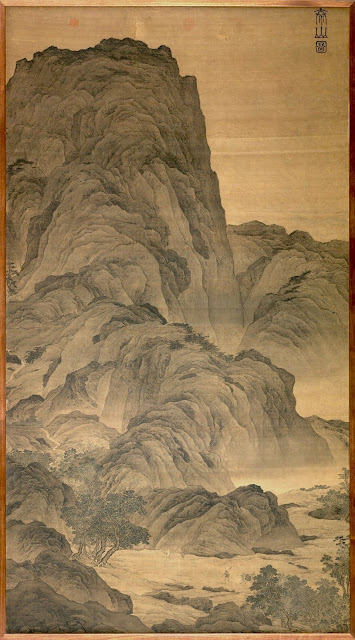ROCKWELL KENT (1882-1971)
Monte Darwin (2,438m - 7,999ft)
Chile (Tierra del Fuego)
In Mountain Lake -Tierra del Fuego, oil on canvas, 1922-25, The Phillips Collection
About the painting
For Duncan Phillips, Rockwell Kent's art embodied "
the eager linear expression of his own abounding energy and gusto for physical adventure in wild and desolate regions," an appropriate description of the small oil panel entitled
Mountain Lake. A record of Kent’s 1922 sailing adventure to the Tierra del Fuego region of South America, it is one of many small studies that may have been painted on site. Kent described the view from his boat, which was anchored in the bay of Bahía Blanca in the Admiralty Sound, noting the emerald green bay and beyond it steep cliffs, heavily wooded, leading to high mountains, still capped with snow.
In
Mountain Lake Kent abandoned his earlier preference for rich impasto and surface texture in favor of a thin, sleek finish. The space, arbitrarily adjusted into abstract, flat patterns, reflects a stylistic kinship with both precisionism—an American movement that was widely influential in the early 1920s—and with the simplified forms of woodblock printing, a medium in which Kent worked over a long period of time.
Kent brought many paintings from this trip back to New York with him in 1923. Though they were well reviewed, the artist sensed a declining interest in realism, despite high degree of simplification, verging on abstraction, present in this image. Phillips, however, greatly appreciated Kent's work and purchased Mountain Lake as a representation of the artist's adventures in South America. Phillips first exhibited the painting in 1926, writing in the exhibition catalogue
"Kent [did] not need abstract vision, for he moves us like mighty music with images drawn from his own romantic experience."
The mountain
Monte Darwin
(2,438m - 7,999ft) is a peak in Isla Grande de Tierra del Fuego forming part of the Cordillera Darwin, the southernmost range of the Andes, just to the north of the Beagle Channel in Chile. It is formed of crystalline schists and has massive glaciers down its steep southern slopes. Monte Darwin was for a long time considered as the highest peak in Tierra del Fuego, but that distinction corresponds to a mountain unofficially named Monte Shipton, which is about 2,580 m (8,460 ft) high and is located at 54°39′33″S 69°35′54″W.
Both peaks are best climbed in late December, January, February and March. Monte Shipton was first climbed in 1962 by Eric Shipton, E. Garcia, F. Vivanco and C. Marangunic.
Mount Darwin was given its name during the voyage of the Beagle by HMS Beagle's captain Robert FitzRoy to celebrate Charles Darwin's 25th birthday on 12 February 1834. A year earlier FitzRoy had named an expanse of water to the southwest of the mountain the Darwin Sound to commemorate Darwin's quick wit and courage in saving them from being marooned when waves from a mass of ice splitting off a glacier threatened their boats.
The mountain is part of Alberto de Agostini National Park.
The painter
Rockwell Kent, artist, author, and political activist, had a long and varied career. During his lifetime, he worked as an architectural draftsman, illustrator, printmaker, painter, lobsterman, ship's carpenter, and dairy farmer. Born in Tarrytown Heights, New York, he lived in Maine, Newfoundland, Alaska, Greenland, and the Adirondacks and explored the waters around Tierra del Fuego in a small boat. Kent's paintings, lithographs, and woodcuts often portrayed the bleak and rugged aspects of nature; a reflection of his life in harsh climates.His experience as a carpenter and builder and his familiarity with tools served him well when he took up the graphic process. His blocks were marvels of beautiful cutting, every line deliberate and under perfect control. The tones and lines in his lithography were solidly built up, subtle, and full of color. He usually made preliminary studies- old-mater style- for composition or detail before starting on a print. Nothing was vague or accidental about his work; his expression was clear and deliberate. Neither misty tonalities nor suggestiveness were to his taste. He was a highly objectified art - clean, athletic, sometimes almost austere and cold. He either recorded adventures concretely, or dealt in ideas. His studio was a model of the efficient workshop: neat, orderly, with everything in its place. His handwriting, the fruit of his architectural training, was beautiful and precise.
Among the many notes of increasing awareness of Kent's contributions to American culture is the reproduction of one of Kent's pen-and-ink drawings from Moby Dick on a U.S. postage stamp, part of the 2001 commemorative panel celebrating such American illustrators as Maxfield Parrish, Frederic Remington, and Norman Rockwell.
2018 - Wandering Vertexes...
Un blog de Francis Rousseau


















